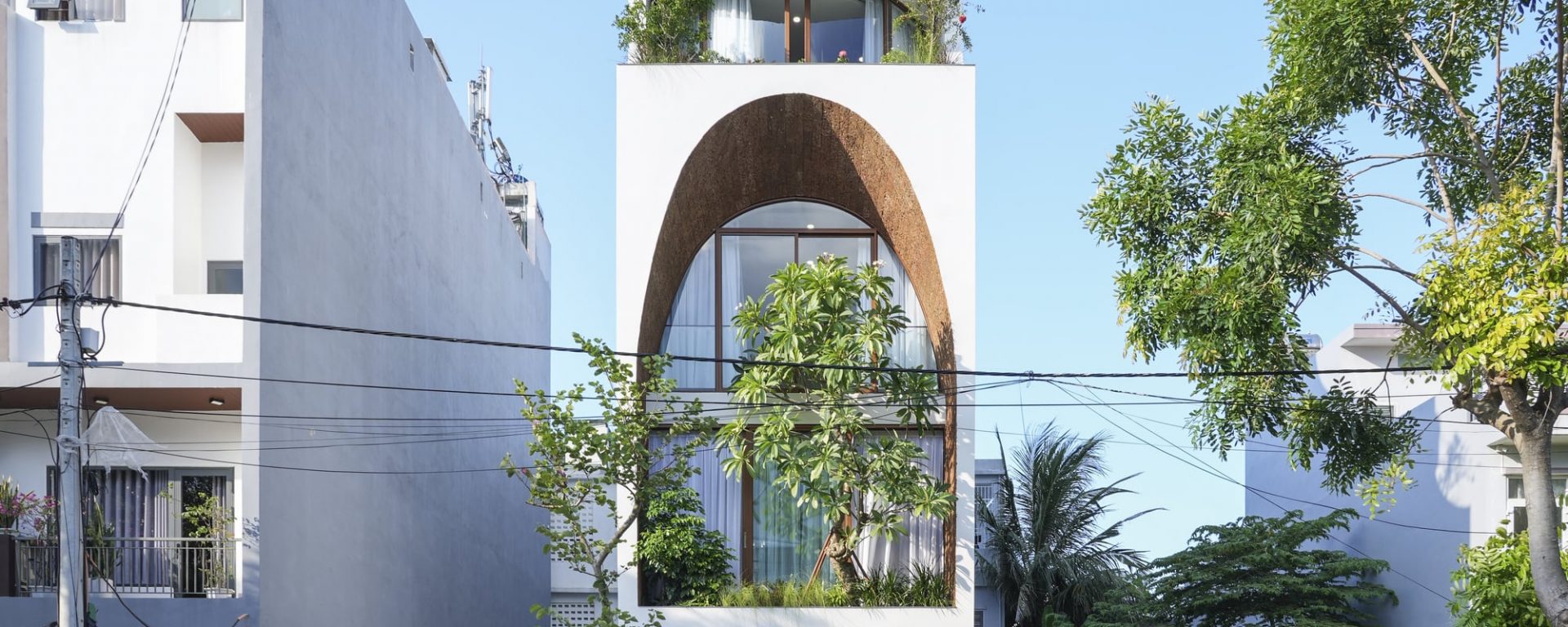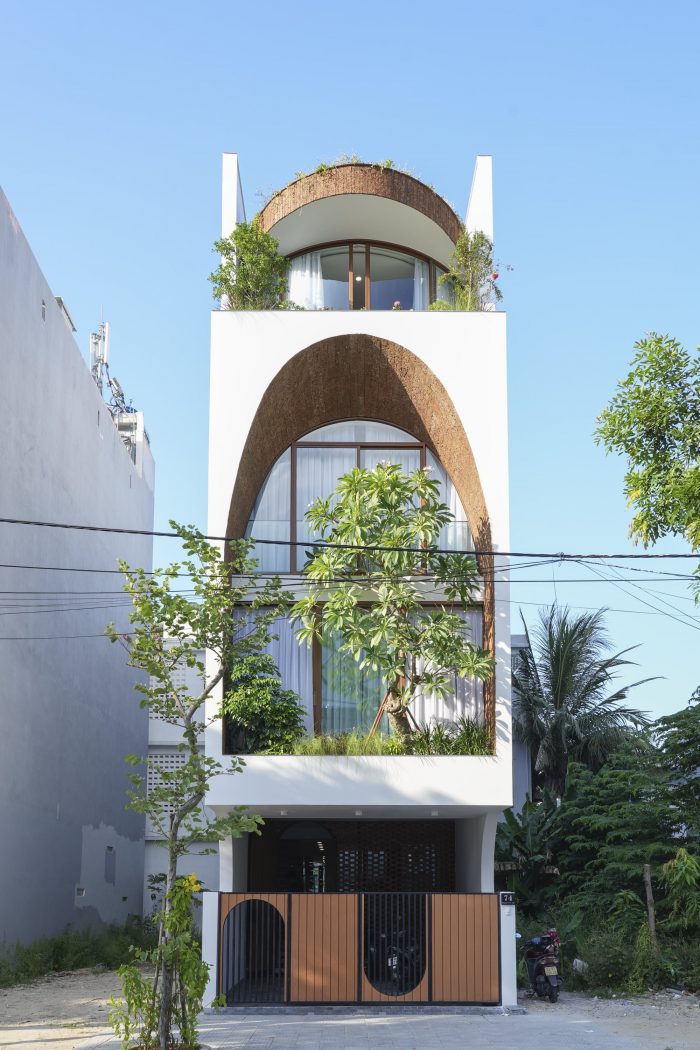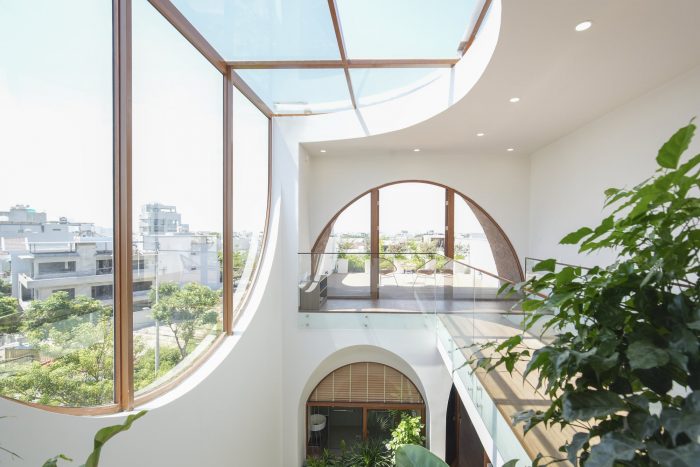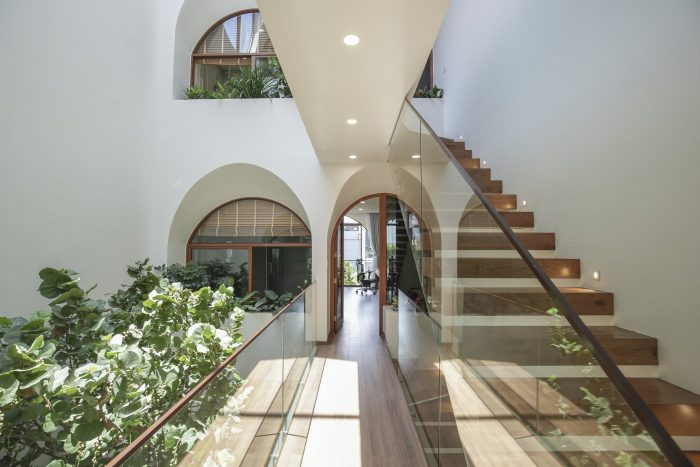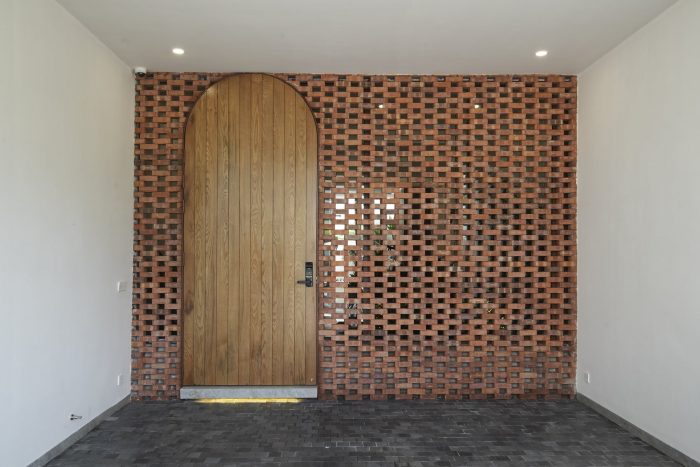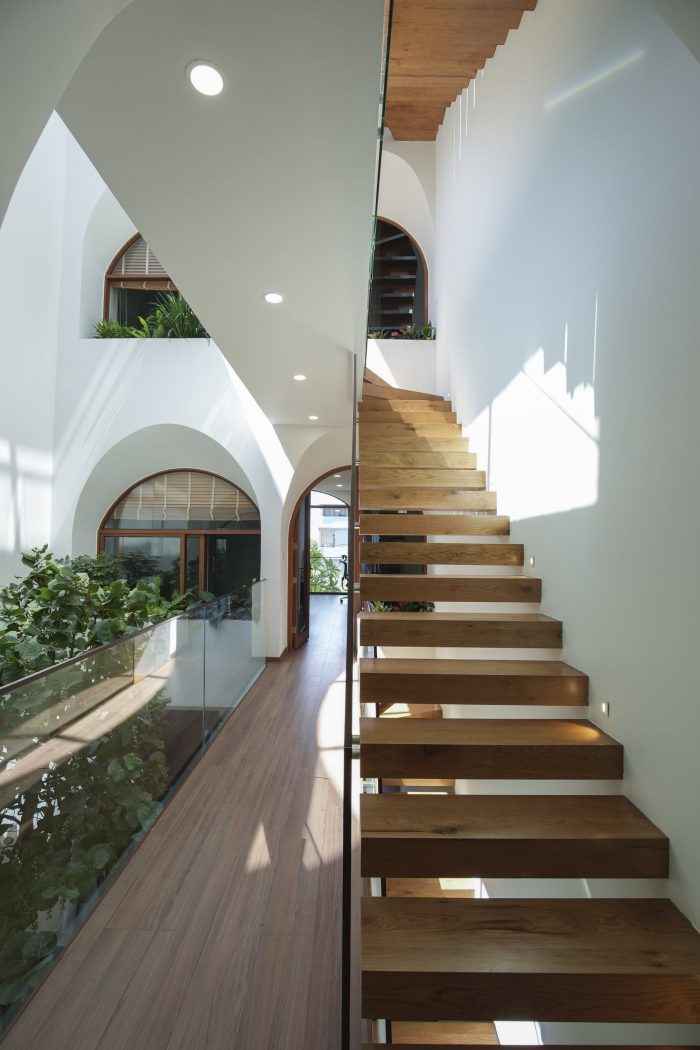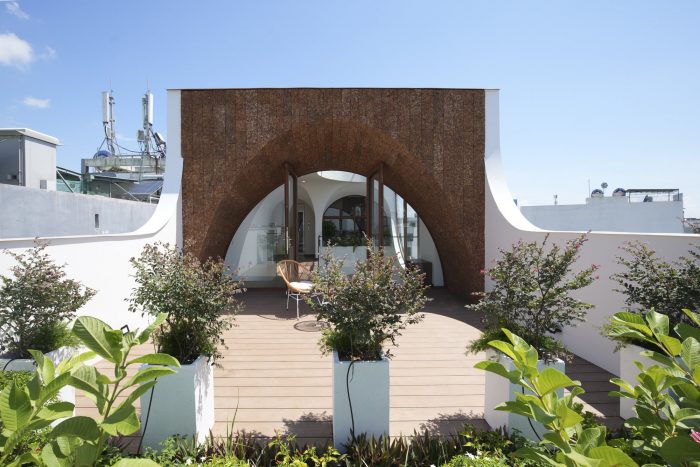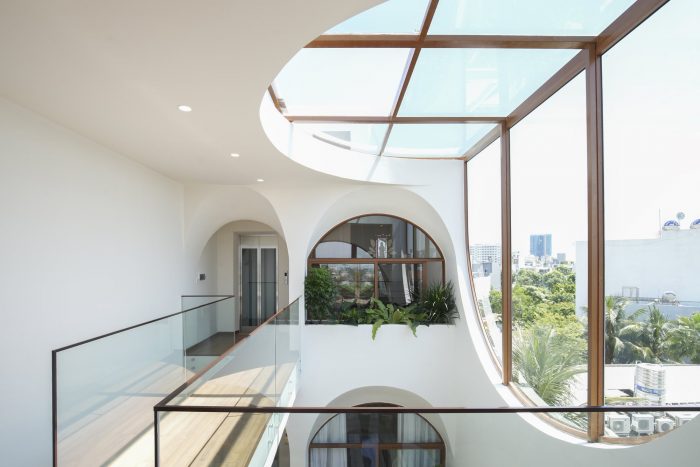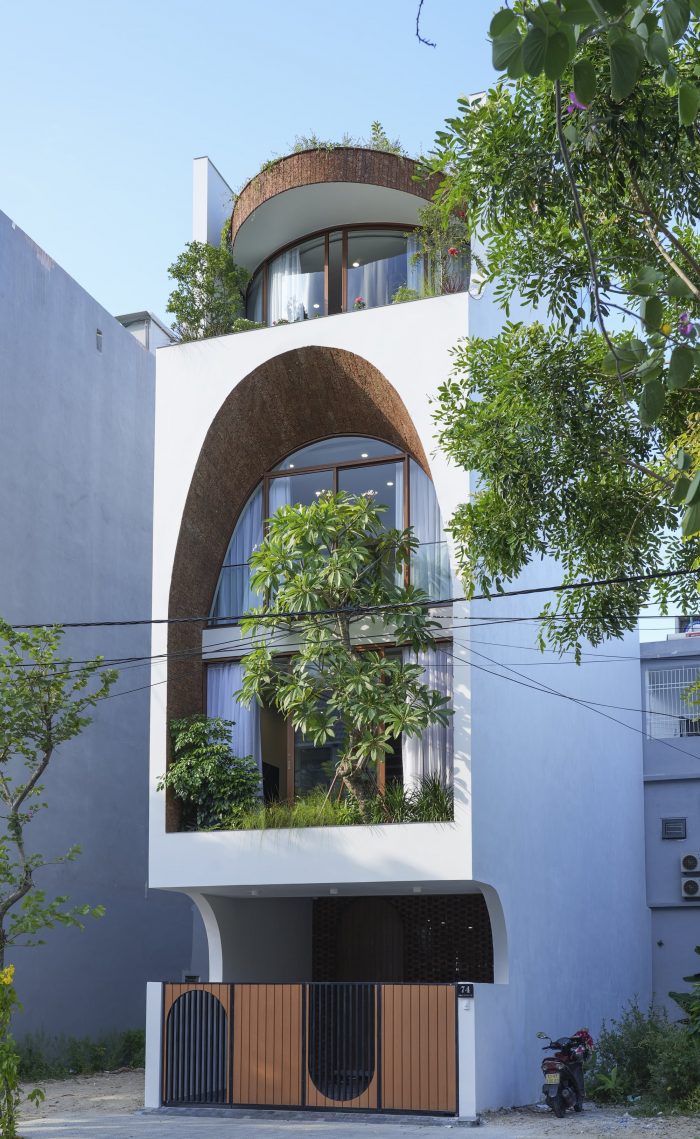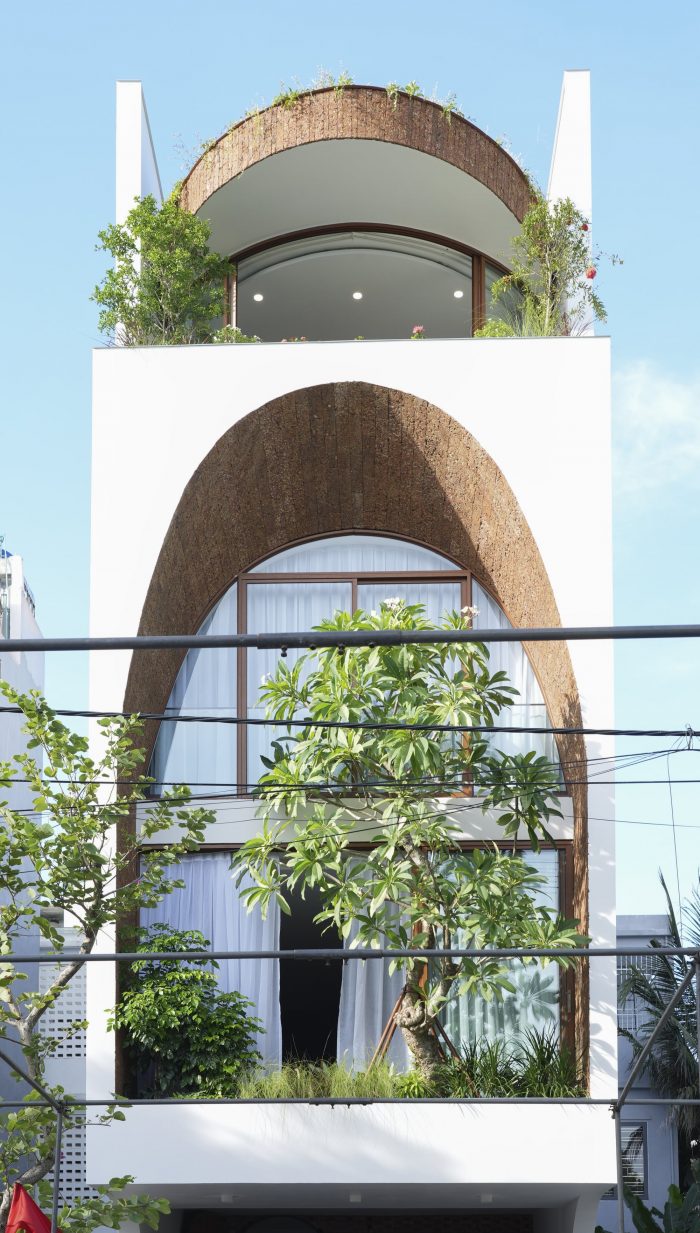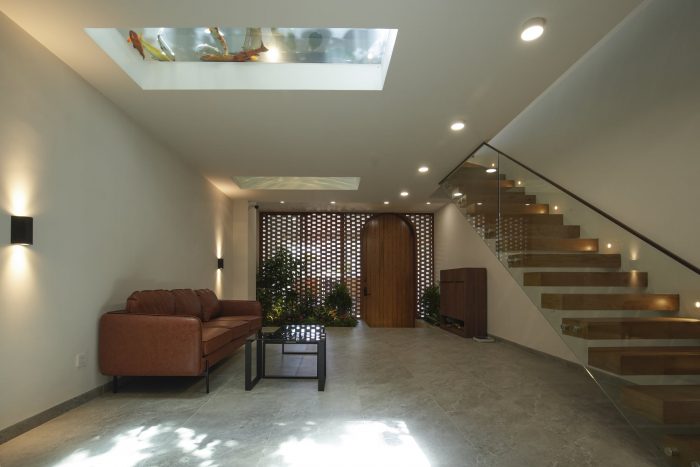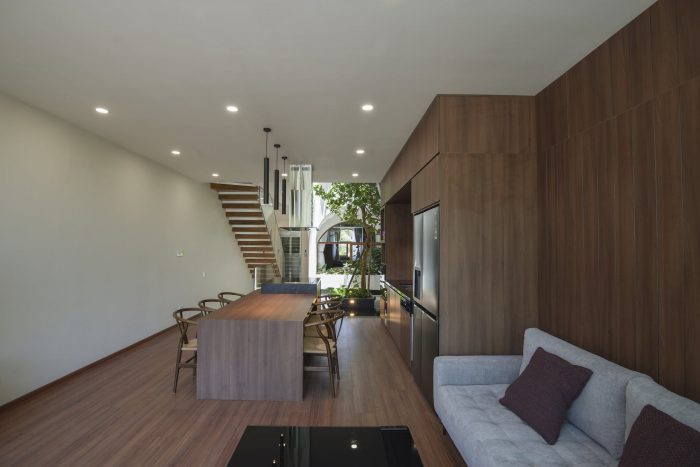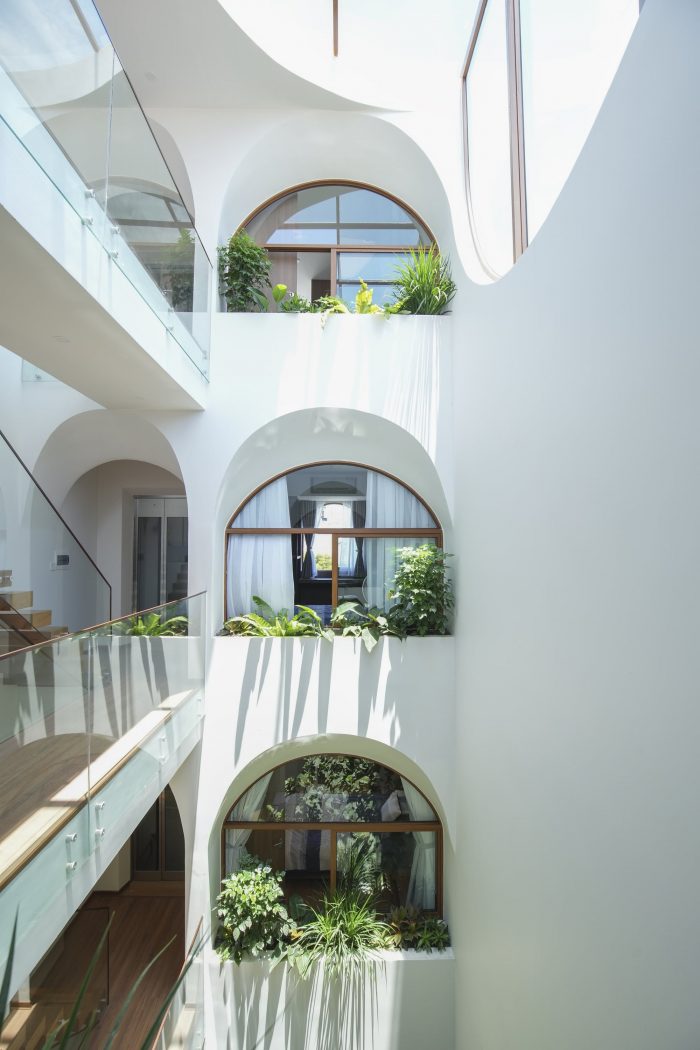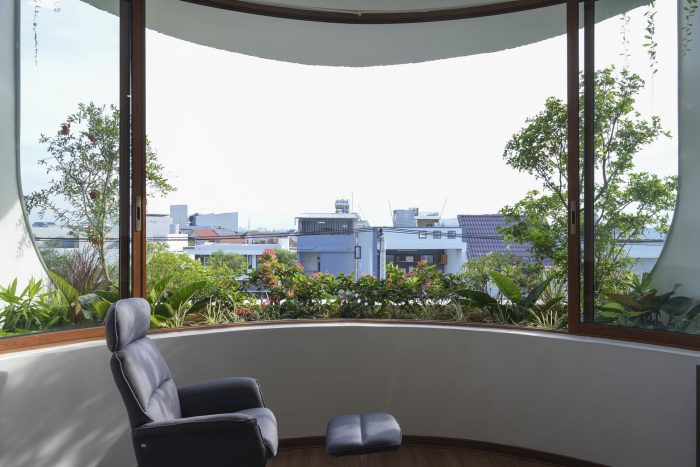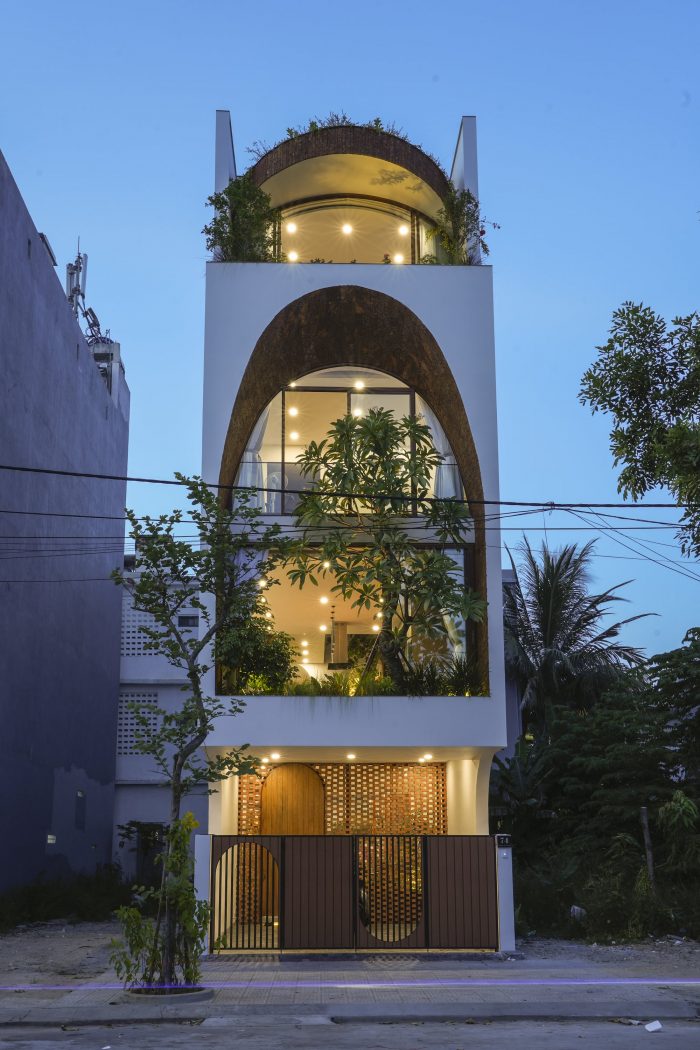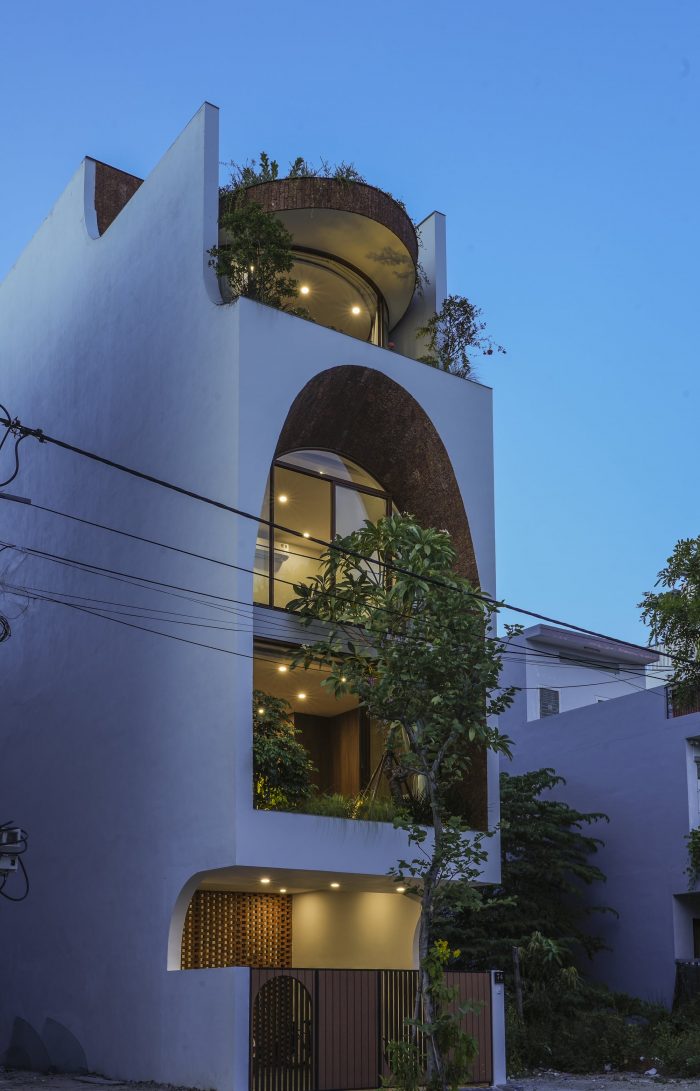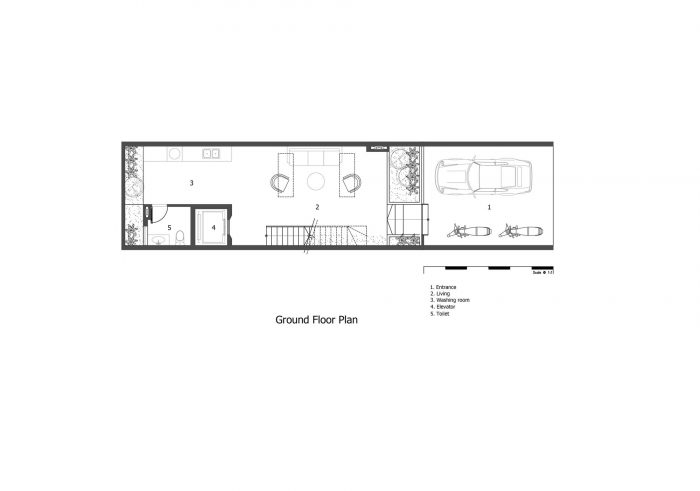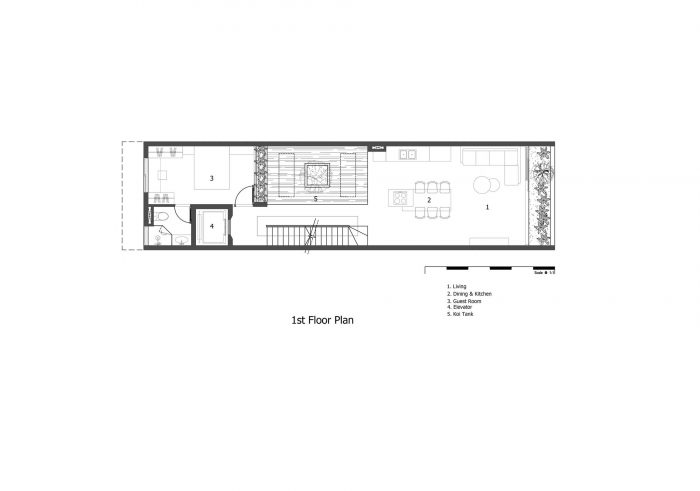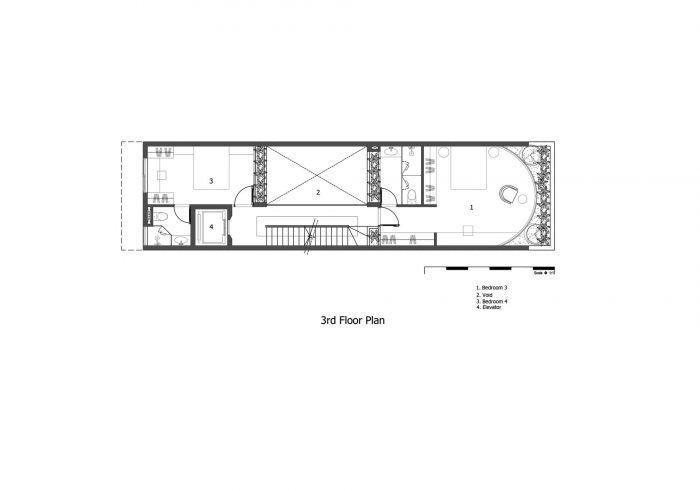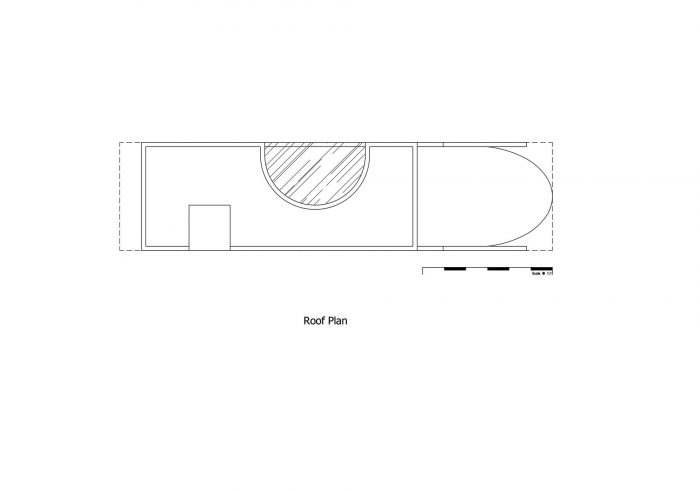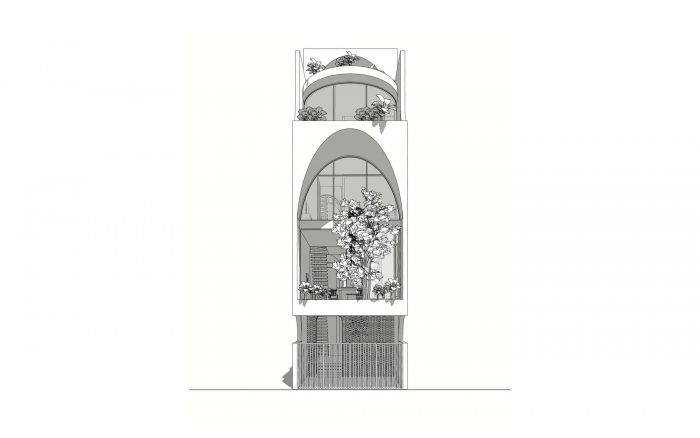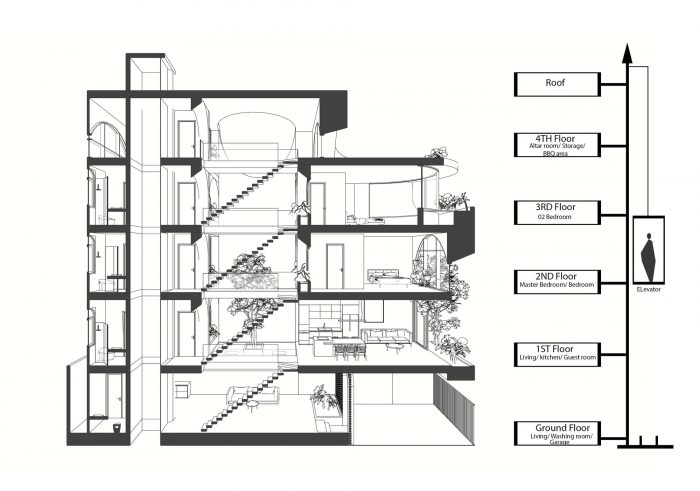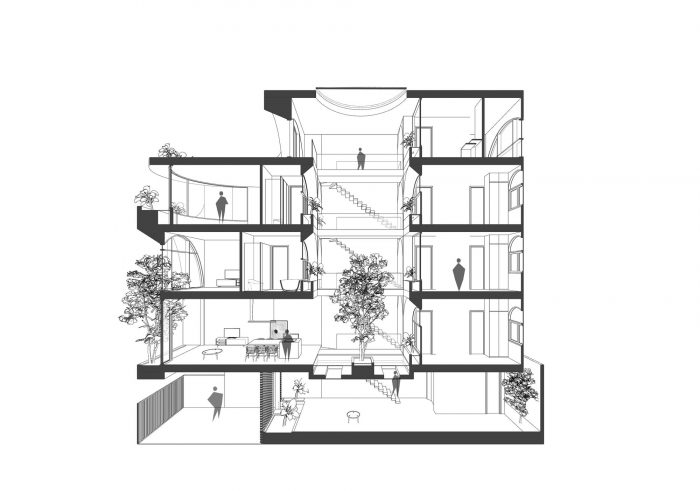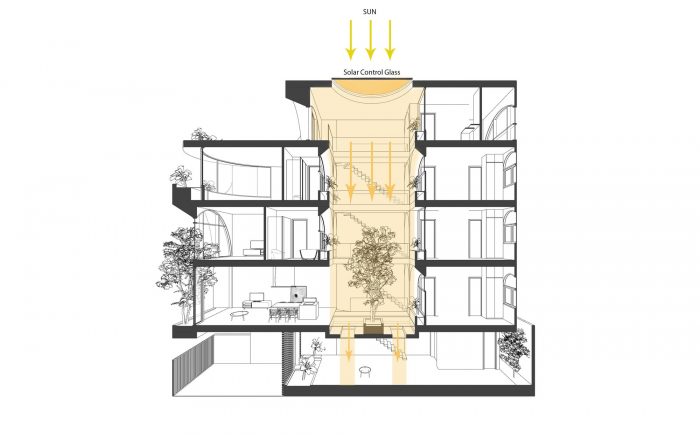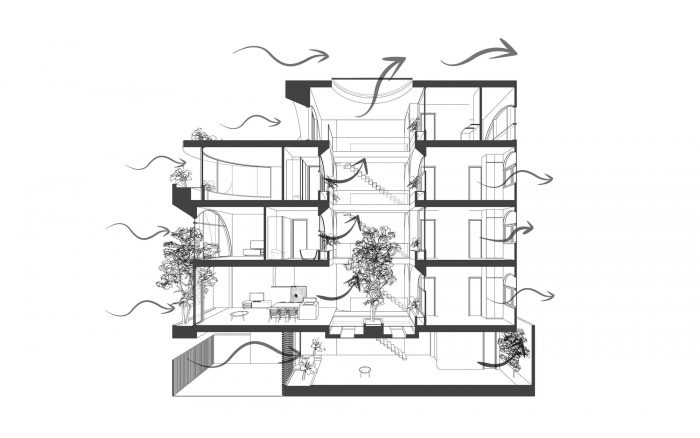在越南有许多小块土地的住房项目,由于人口密度高,大多在城市地区。这些地块适合于收入大多数的人。然而,它的狭长性也带来了许多弱点。两个最大的问题是缺乏光线和通风;特别是当与极端炎热和潮湿的热带气候相结合时。因此,这些项目需要建筑师的解决方案来解决这些问题。
There are many housing projects with small plots of land in Vietnam, mostly in urban areas due to the high population density. These land lots are suitable for the income majority. However, its narrowness comes with many weaknesses. The two biggest problems are lack of light and ventilation; especially when combined with the extremely hot and humid tropical climate. Therefore, these projects require Architects’ solutions to solve these problems.
下面这个房子就是一个典型的例子。其典型面积为5米,x20米,必须足够5个人使用。总的来说,为了解决上面提到的问题,我们把房子分为三个部分:前面,和后面,我们牺牲了中间的一个大空间,以便能够把光线和风带到房子里面。在底层,最外面的是停车区。这个空间用砖墙与居住空间隔开,因为它含有大量来自车辆的有毒物质。再往里走是一扇玻璃门,便于控制风和视野。中间是一个临时座位区和一个洗衣区。最后,有一个小天窗,用于空气对流和晾晒衣服。
The house below is a typical example. With a typical area of 5m, x 20m and must be enough for 5 people to use. Overall, to solve the problem mentioned above we divided the house into three parts: front, and back and we sacrificed a large space in the middle to be able to bring light and wind inside the house. On the ground floor, the outermost is the parking area. This space is separated from the living space by a brick wall because it contains a lot of toxic substances from vehicles. Further inside is a glass door for easily controlling the wind and the view. In the middle is a temporary seating area and a laundry area. Finally, there is a small skylight for air convection and for drying clothes.
在一楼,公共房间和厨房被安排在前面,后面是一个小卧室。在这两个区域之间是一个水族馆和绿化空间,这使公共生活空间更接近自然。池塘也是一种减少热量的物理方法,同时也是住户的一种心理释放。在水族馆的中间,我们没有完全用混凝土来做,而是用玻璃底,把更多的自然光带到一楼的临时座位区。通过这种方法,客人可以看到更多的光线和游鱼,创造一个舒缓的放松空间。
On the first floor, the common room and the kitchen are arranged in front and a small bedroom in the back. In between these two areas is an aquarium and greenery space, which bring the common living space closer to nature. The pond is also a physical method for reducing heat as well as a psychological release for tenants. In the middle of the aquarium, instead of being completely made of concrete, we used a glass bottom to bring more natural light down to the temporary seating area on the ground floor. By this method, guests can see more light and swimming fish, creating a soothing relaxing space.
在二楼和三楼,大卧室被安排在前面,而小卧室则位于后面。这两个空间由一个桥形走廊连接。中间是一个大天窗,从四楼到一楼贯穿始终。在这个天窗周围,我们安排了很多树木。你会觉得你可以在任何地方触摸到它们。一个特别的特点是,卧室和浴室都暴露在直射光下,这是一种实用的使用方式,同时也对健康非常有利。
On the 2nd and 3rd floors, large bedrooms are arranged in the front, and smaller bedrooms are located at the rear. These two spaces are connected by a bridge corridor. In the middle is a large skylight throughout from the 4th to the ground floor. Around this skylight, we arrange a lot of trees. You will feel like you can touch them anywhere. A special feature is that the bedrooms and bathrooms are all exposed to direct light, which is a practical way of use as well as very good for health.
在4楼,有一个小的果园花园,用于放松和家人的私人用餐。在这个空间里,我们使用树木和木质地板,以此来防止低层楼的热量。因此,避免混凝土的热收缩也是防水的一个好措施。在屋顶上,我们在混凝土地板上使用XPS耐热板,以有效保护和耐热。对于天窗上的玻璃屋顶,我们使用了中空玻璃,它限制了传入室内的有害紫外线,但仍能充分利用光源。这个屋顶可以因条件天气的变化而自动打开和关闭。整个植物浇灌系统是自动的,以减少时间和精力。
On the 4th floor, there is a small orchard garden for relaxing and for the family’s private dining. In this space, we use trees and wooden floors as a way to prevent heat on the lower floors. Avoiding heat shrinkage of concrete is therefore also a good measure for waterproofing. On the Roof, we use XPS heat-resistant panels on the concrete floor for effective protection and heat resistance. For the glass roof over the skylight, we use insulated glass which limits harmful UV rays incoming into the house, but still makes the most of the light source. This roof can automatically open and close due to the condition weather. The entire plant watering system is automatic to reduce time and effort.
在房子的正门,我们也使用了许多当地材料,如烤砖和典型的越南石材。To Ong (Laterite) 石头,这种石头在几百年前就被用于建筑;与树木相结合,创造出自己的独特性,但仍然非常接近传统建筑。
In the main gate of the house, we also use many local materials such as baked bricks and the typical Vietnamese stone: To Ong (Laterite) stone, this stone was used hundreds of years ago in construction; in combination with trees to create its own uniqueness but still very close to traditional construction.
Architects: 85 Design
Area : 100 m²
Year : 2022
Photographs :To Huu Dung
Manufacturers : Electrolux, DaiDuong Glass, Atarashi Window, Bosch, Hafele, Ikea
Contractors : Antcons
Architect In Charge & Architectural Design : To Huu Dung
Structural Engineers : Dao Ngoc Son
MEP : Thinh Tran
Interior Design : Trinh Mai Giang
City : Ngũ Hành Sơn
Country : Vietnam

